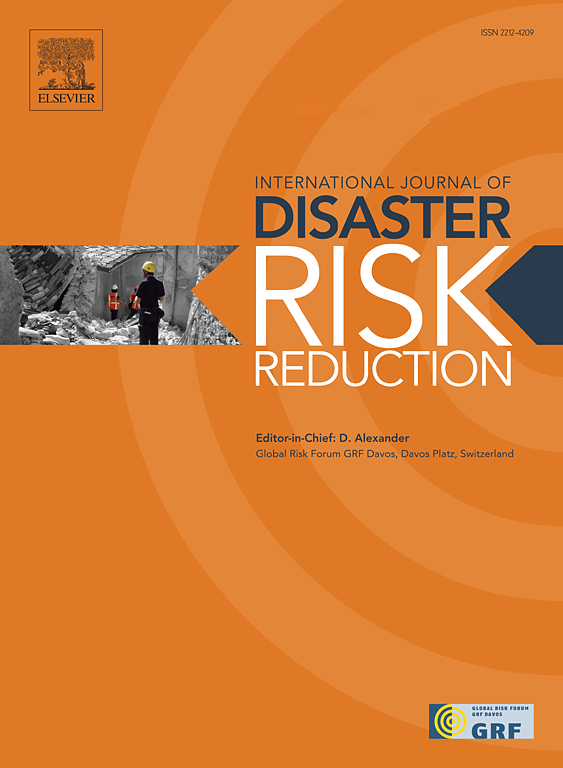Quantifying road criticality through the impact of disruptions on pavement deterioration and agency maintenance costs
IF 4.2
1区 地球科学
Q1 GEOSCIENCES, MULTIDISCIPLINARY
International journal of disaster risk reduction
Pub Date : 2025-06-04
DOI:10.1016/j.ijdrr.2025.105592
引用次数: 0
Abstract
Road pavement deterioration depends on several factors, such as traffic loads and environmental conditions. Extreme natural hazard events, such as earthquakes, floods, and hurricanes, have significantly damaged road infrastructure over the years, further exacerbating road deterioration. While Transportation Asset Management (TAM) traditionally focuses on normal stressors to estimate road deterioration, recent research has incorporated the effects of natural hazards through fragility and exposure assessments. However, the impact of traffic detours caused by natural hazard events on road remaining life and maintenance costs has not been studied to the best knowledge of the authors. This paper, therefore, proposes a methodology to quantify the effect of highway disruptions on the maintenance cost and remaining life of pavements. The methodology is applied to the South Island of New Zealand, assessing the criticality of primary highway networks, using a “full-scan” approach. Results show that local roads are highly vulnerable to traffic detours, with increases in average monthly maintenance costs up to 289% in the most critical disruptions. The proposed approach offers a valuable tool for transportation agencies to assess road network criticality and predict the consequences of traffic detours following disruptions.
通过中断对路面恶化和机构维护成本的影响来量化道路的临界性
道路路面的恶化取决于几个因素,如交通负荷和环境条件。多年来,地震、洪水和飓风等极端自然灾害事件严重破坏了道路基础设施,进一步加剧了道路的恶化。虽然交通资产管理(TAM)传统上侧重于评估道路恶化的正常压力因素,但最近的研究通过脆弱性和暴露评估纳入了自然灾害的影响。然而,据笔者所知,自然灾害事件引起的交通绕行对道路剩余寿命和养护成本的影响尚未得到研究。因此,本文提出了一种方法来量化公路中断对路面维护成本和剩余寿命的影响。该方法应用于新西兰南岛,使用“全面扫描”方法评估主要公路网的临界性。结果表明,当地道路极易受到交通绕行的影响,在最严重的交通中断中,平均每月维护成本增加了289%。提出的方法为交通运输机构提供了一个有价值的工具,可以评估道路网络的临界性,并预测交通中断后绕行的后果。
本文章由计算机程序翻译,如有差异,请以英文原文为准。
求助全文
约1分钟内获得全文
求助全文
来源期刊

International journal of disaster risk reduction
GEOSCIENCES, MULTIDISCIPLINARYMETEOROLOGY-METEOROLOGY & ATMOSPHERIC SCIENCES
CiteScore
8.70
自引率
18.00%
发文量
688
审稿时长
79 days
期刊介绍:
The International Journal of Disaster Risk Reduction (IJDRR) is the journal for researchers, policymakers and practitioners across diverse disciplines: earth sciences and their implications; environmental sciences; engineering; urban studies; geography; and the social sciences. IJDRR publishes fundamental and applied research, critical reviews, policy papers and case studies with a particular focus on multi-disciplinary research that aims to reduce the impact of natural, technological, social and intentional disasters. IJDRR stimulates exchange of ideas and knowledge transfer on disaster research, mitigation, adaptation, prevention and risk reduction at all geographical scales: local, national and international.
Key topics:-
-multifaceted disaster and cascading disasters
-the development of disaster risk reduction strategies and techniques
-discussion and development of effective warning and educational systems for risk management at all levels
-disasters associated with climate change
-vulnerability analysis and vulnerability trends
-emerging risks
-resilience against disasters.
The journal particularly encourages papers that approach risk from a multi-disciplinary perspective.
 求助内容:
求助内容: 应助结果提醒方式:
应助结果提醒方式:


